Mini Garden Ideas for Small Spaces: Maximizing Greenery in Compact Areas
Do you wish for a lush green retreat but feel limited by your small space? You’re not alone. Whether it’s a compact balcony, a windowsill, or a cozy corner of your home, many of us face the challenge of finding room for greenery in our urban lifestyles. Luckily, mini gardens offer the perfect solution, proving that even the smallest spaces can bloom with life and vibrancy.
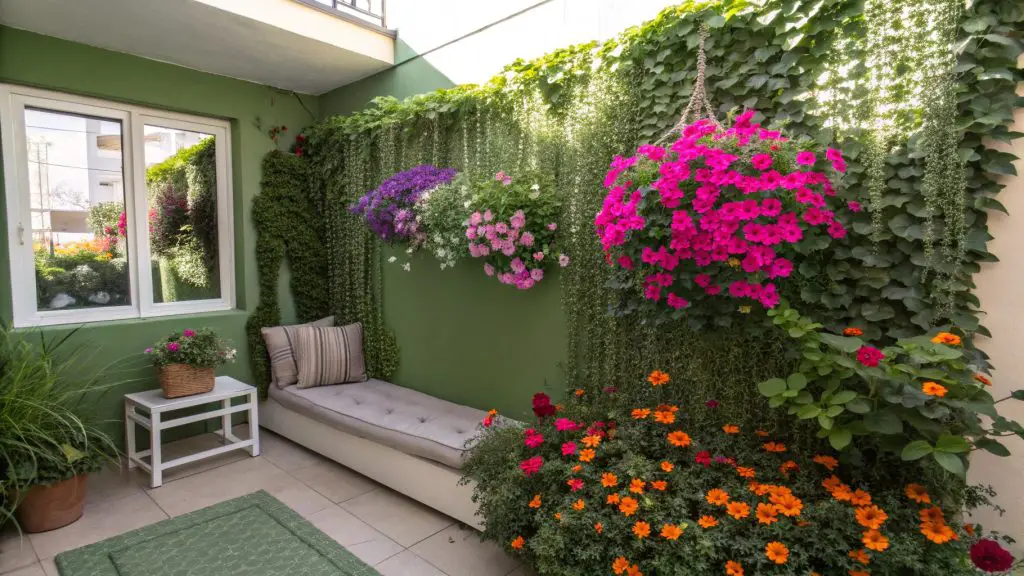
Mini gardens are redefining the way we think about gardening. In urban living and small-space environments, the idea of creating a thriving garden may seem out of reach, but mini gardens make it entirely possible. These small-scale green sanctuaries are designed to fit into tight spaces while providing immense benefits to both mind and body.
Having a mini garden isn’t just about aesthetics, though the visual appeal is undeniable. These compact gardens can help reduce stress, improve air quality, and bring a slice of nature into your daily routine. Imagine the calming presence of a small herb garden on your kitchen windowsill or a vertical garden breathing life into your balcony.
Below, we’ll explore mini garden ideas for small spaces, covering everything from planning to maintenance. With a mix of inspiration, practical tips, and step-by-step guidance, you’ll discover how to transform any nook into a vibrant green haven. Let’s dive into the world of mini gardening and unlock the endless possibilities it holds for your compact spaces.
Understanding Mini Gardens
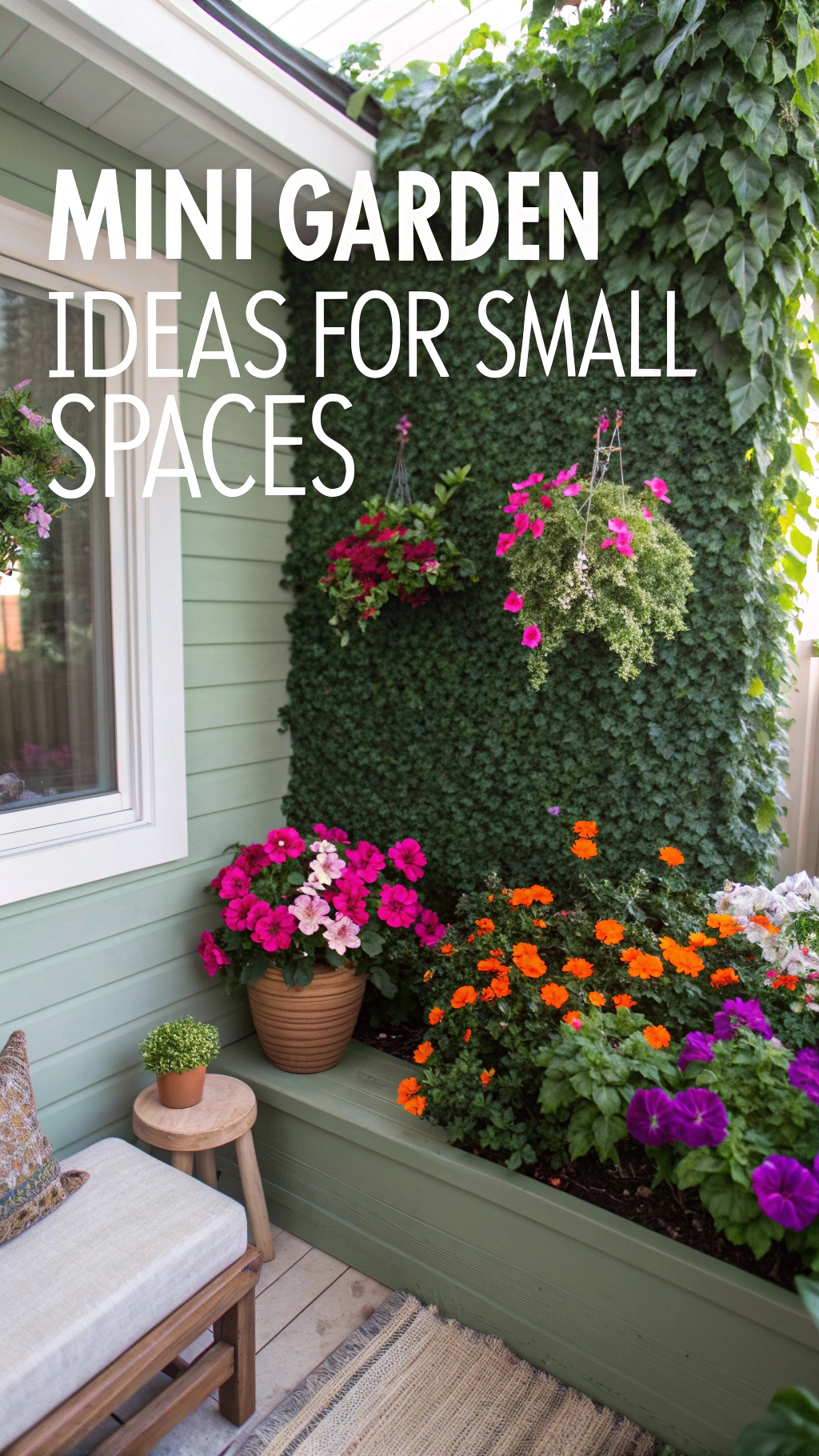
A mini garden is a scaled-down version of traditional gardening, tailored to fit small spaces without compromising on beauty or functionality. Unlike sprawling outdoor gardens, mini gardens thrive in compact environments, making them ideal for urban living. These gardens aren’t just limited to outdoor patios or balconies; they can flourish indoors on windowsills, desks, or even tabletops.
What makes mini gardens unique is their versatility. You can opt for vertical gardens that climb walls, container gardens filled with vibrant flowers, or even miniature rock gardens that add texture and charm. Each option allows you to customize your green space based on available room, aesthetic preferences, and maintenance needs.
One of the key appeals of mini gardens lies in their adaptability. They bring the outdoors in and transform even the tiniest spaces into pockets of tranquility. For instance, a sunny balcony might house potted herbs and flowers, while a shaded corner could host a lush, fern-filled arrangement. With their ability to integrate seamlessly into various environments, mini gardens also align with the principles of biophilic design, reconnecting people with nature in meaningful ways.
Whether you’re looking to brighten your indoor spaces, create an outdoor sanctuary, or blend both, mini gardens offer an opportunity to enhance your living environment with minimal effort.
Planning Your Mini Garden
Assess Your Space
The first step in creating a mini garden is evaluating your available space. Observe your chosen area to understand its light conditions, airflow, and climate. For example, a windowsill that gets plenty of sunlight is perfect for succulents, while a shady patio might be better suited for ferns or moss gardens. Knowing your space will help you make informed decisions about plants and layouts.
Choose a Theme
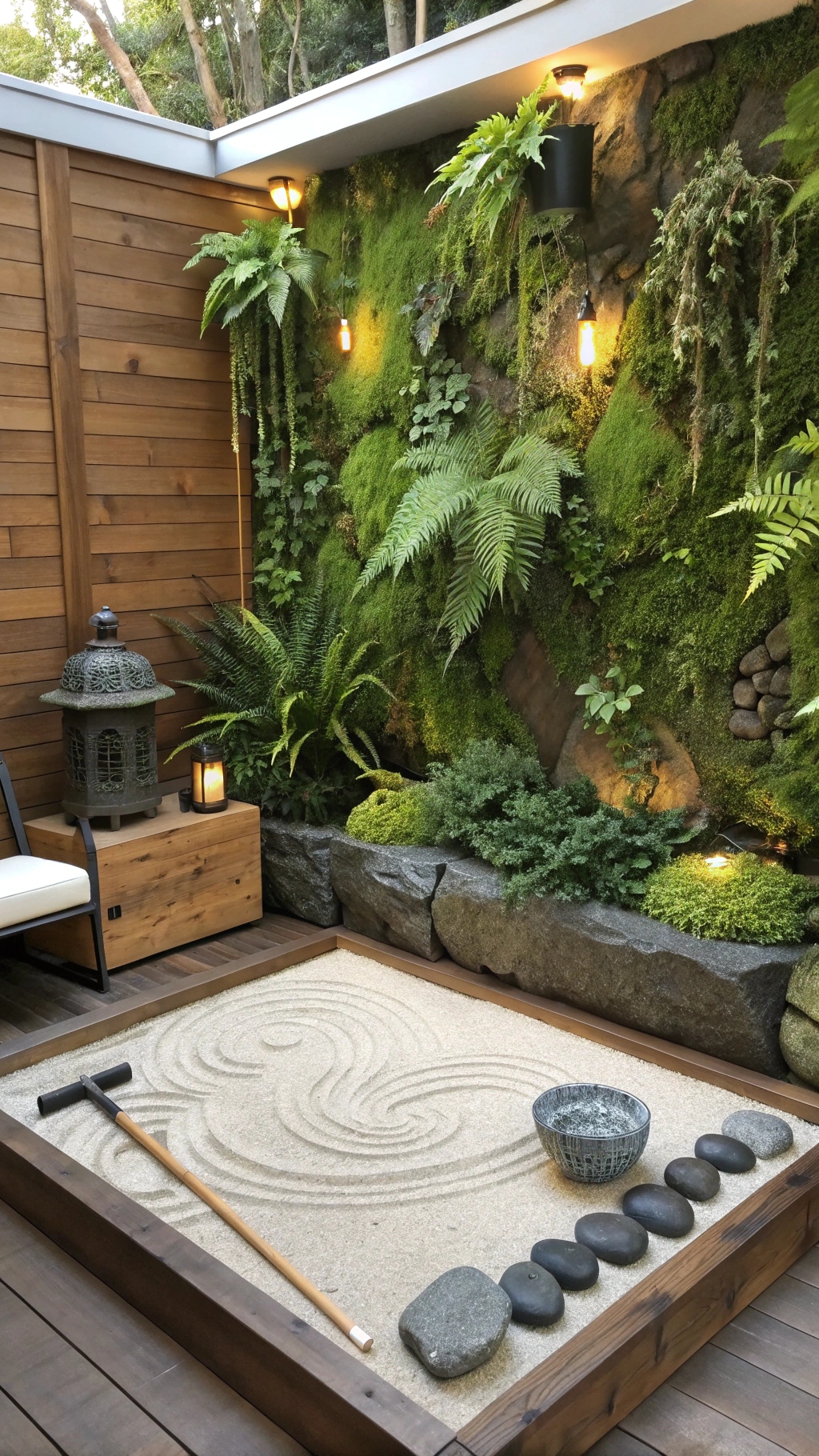
Mini gardens can be even more engaging when they follow a theme. Consider options like a succulent garden for a sleek, modern look, a herb garden for culinary convenience, or a fairy garden with whimsical elements. A zen garden, with its calming arrangement of rocks and plants, is perfect for those seeking serenity. Themed gardens not only look cohesive but also reflect your personality and style.
Select the Right Plants
Small spaces call for plants that are both compact and easy to care for. Succulents, herbs like basil and thyme, and ferns are all great choices for beginners. Dwarf plant varieties, such as mini roses or bonsai trees, can add visual interest without overwhelming your space. Remember to match plants with the conditions of your area—low-light plants for shaded spots and sun-loving varieties for brighter locations.
Consider Containers
The right containers can elevate the look and functionality of your mini garden. Repurposed items like mugs, jars, or tin cans add a quirky touch, while hanging planters and wall pockets are excellent for maximizing vertical space. For a more cohesive look, choose containers that complement your overall theme and ensure proper drainage to keep your plants healthy.
With a clear plan and thoughtful choices, you’ll be ready to bring your mini garden vision to life. Next, we’ll explore creative ideas to transform your small spaces into lush green escapes.
Creative Mini Garden Ideas for Small Spaces
#1 Vertical Gardens
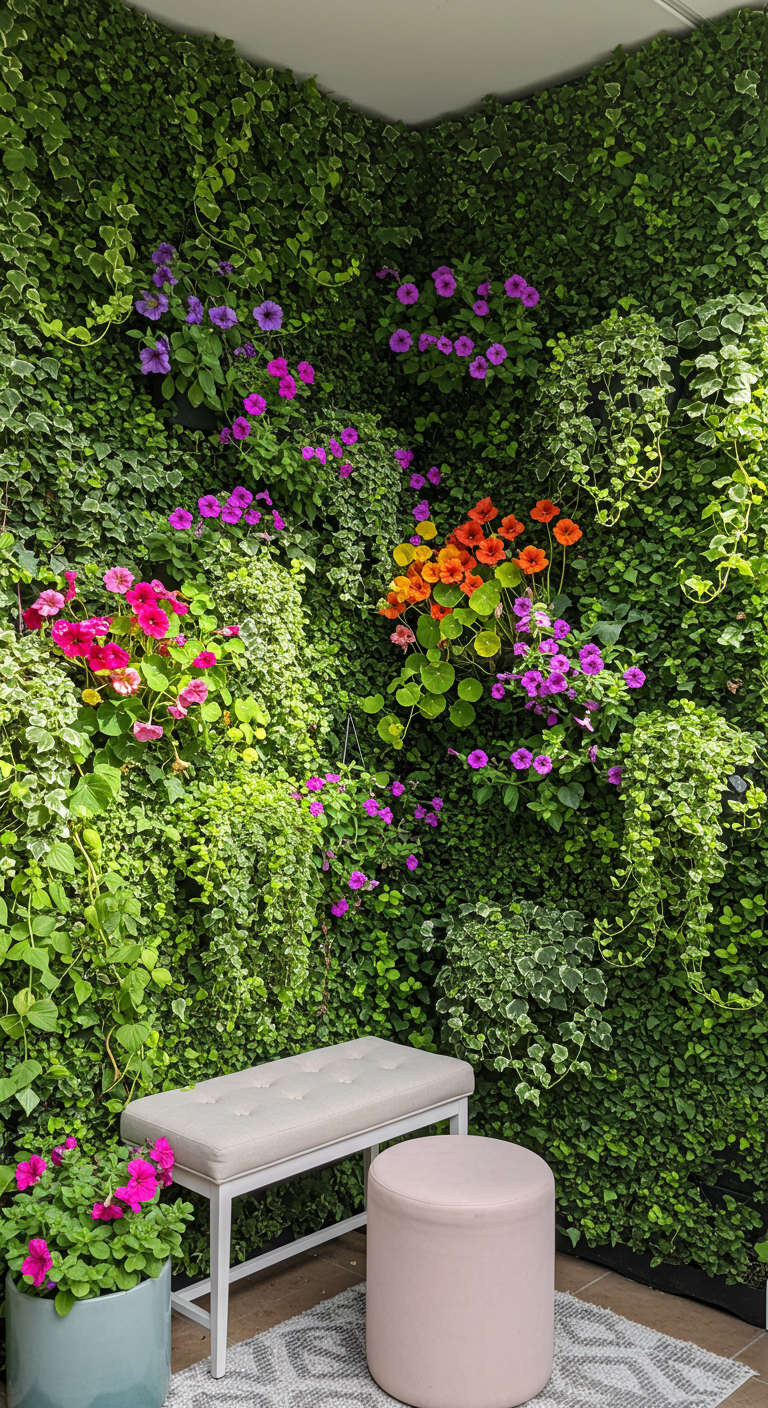
Description
Vertical gardens are a fantastic way to maximize greenery without using up valuable floor space. They can transform a plain wall into a lush, living masterpiece, perfect for balconies, patios, or even interior spaces. This option is ideal for climbing plants like pothos, ivy, or even vegetables like cherry tomatoes and beans.
How to Do It
To create a vertical garden, start with a trellis, wall-mounted planter pockets, or a wooden pallet. Attach your chosen support to a sturdy wall or railing. Arrange plants strategically, with larger or cascading varieties at the top for visual appeal. Use lightweight pots and ensure proper irrigation, as vertical setups tend to dry out faster.
Visual Cue
Picture a vibrant green wall with cascading ivy and bright pops of color from flowering plants like petunias or nasturtiums. A well-lit corner with these cascading greens is both functional and stunning.
#2 Miniature Rock Garden in a Bowl
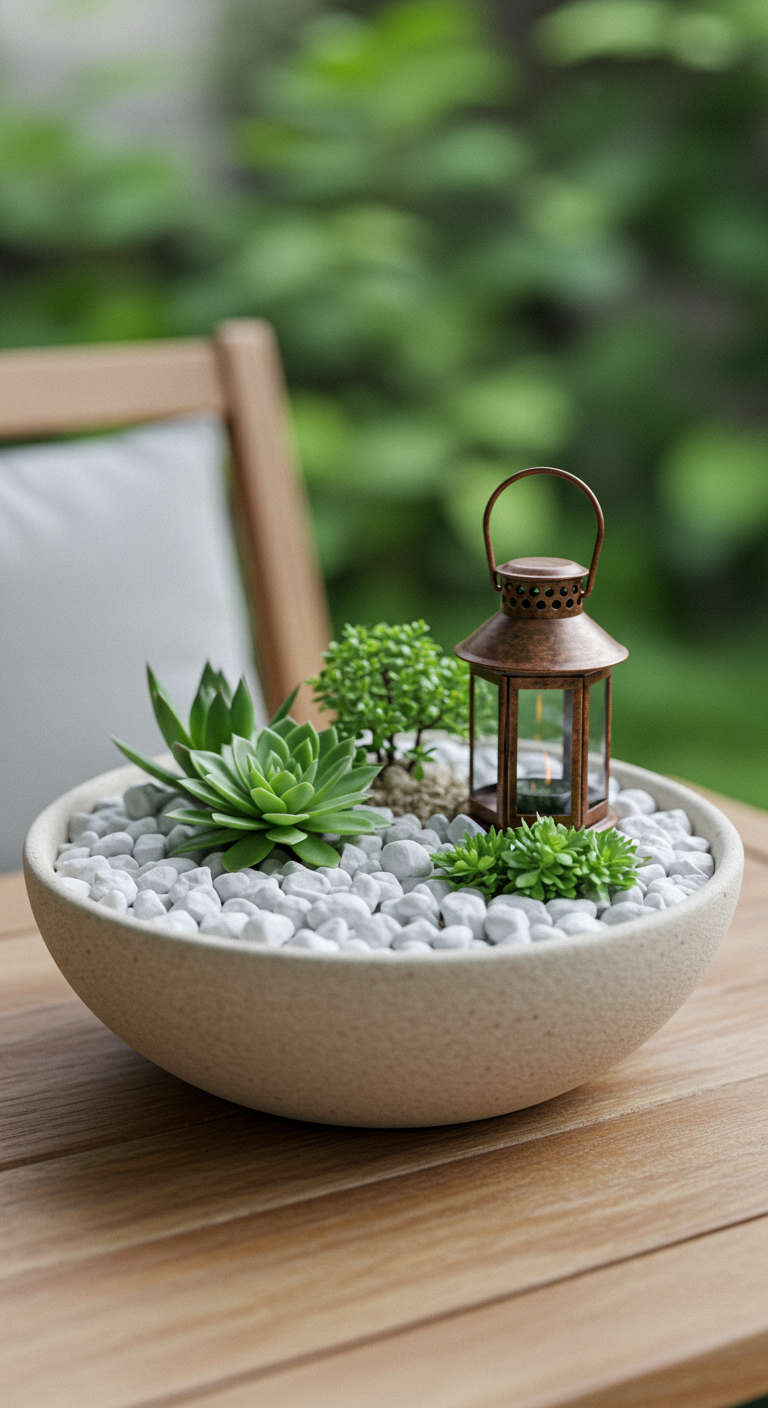
Description
For those seeking a low-maintenance and visually striking option, a miniature rock garden is a perfect choice. Combining drought-tolerant plants like succulents and cacti with rocks and pebbles creates a natural, serene look that fits anywhere, from a tabletop to a patio corner.
How to Do It
Choose a shallow container or a designated patch in your space. Arrange rocks and pebbles of various sizes to create texture and height. Add drought-resistant plants like echeveria or jade plants in the gaps, ensuring the soil has excellent drainage. For extra charm, incorporate decorative elements like miniature statues or colored stones.
Visual Cue
Imagine a shallow ceramic bowl with smooth, white pebbles, interspersed with small green succulents and a tiny decorative lantern. This setup is both calming and easy to maintain.
#3 Mini Rock Gardens for Small Outdoor Spaces
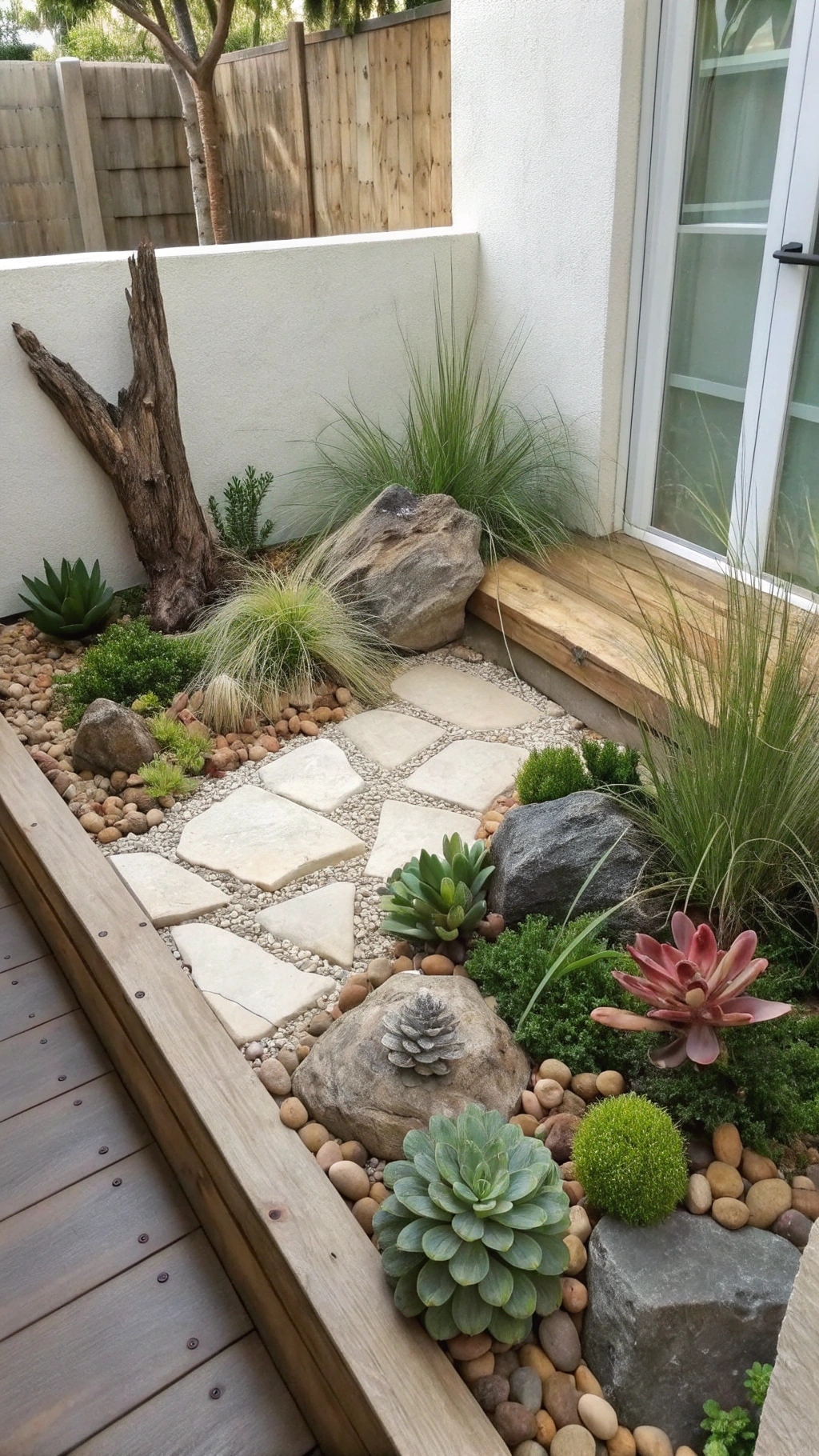
Description
A mini rock garden is an excellent way to transform a small outdoor space of about 4 square meters into a low-maintenance, visually striking retreat. By combining drought-tolerant plants with rocks, pebbles, and other natural elements, you can create a serene and cohesive design that enhances your outdoor area. This setup is perfect for those who want a unique and tranquil space that requires minimal upkeep.
How to Do It
- Prepare the Area: Clear the designated space of weeds and debris. Lay down a weed barrier fabric to minimize maintenance.
- Create the Base: Cover the area with gravel, sand, or a mix of the two to establish a well-drained foundation.
- Arrange Rocks: Place larger rocks or boulders as focal points. Use medium and small-sized stones to fill gaps and create layers, ensuring a natural flow.
- Add Plants: Choose drought-resistant plants such as succulents, cacti, or ornamental grasses like blue fescue. Space them strategically, leaving room for growth and creating balance with the rock arrangement.
- Decorate: Enhance the garden with elements like driftwood, colored stones, or small outdoor sculptures. Pathways made of flat stones or stepping stones can add functionality and charm.
- Finishing Touches: Mulch around plants with decorative gravel to suppress weeds and give the garden a polished look.
Visual Cue
Picture a cozy 4-square-meter outdoor nook with a mix of smooth pebbles and rugged boulders, interspersed with vibrant green succulents and wispy grasses. A small stone pathway weaves through the garden, leading to a central feature like a weathered driftwood sculpture. The result is a tranquil, minimalist space that blends perfectly with its surroundings.
This setup is both calming and practical, making it an ideal choice for small outdoor areas.
#4 Upcycled Mini Gardens
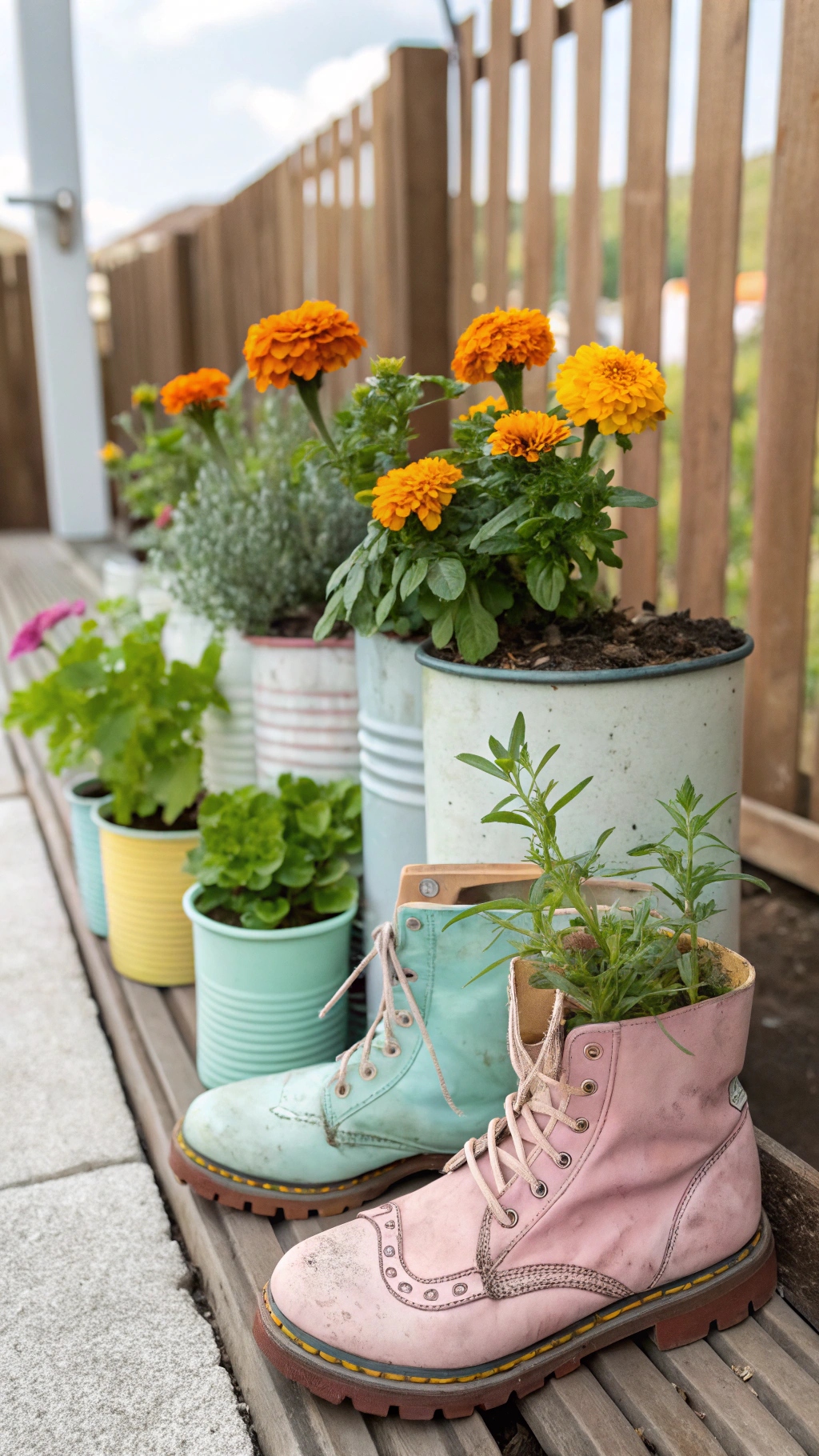
Description
Turn everyday household items into creative planters for a quirky and sustainable mini garden. Old teapots, boots, or even wooden crates can be repurposed to give your garden a unique and personal touch.
How to Do It
Start by gathering unused or discarded items around your home. Ensure they’re clean and drill small drainage holes if needed. Fill them with soil and your chosen plants. For a cohesive look, paint or decorate the containers to match your space. Mix and match sizes and shapes for an eclectic feel.
Visual Cue
Picture an old boot turned into a planter, overflowing with vibrant marigolds, or a row of tin cans painted in pastel hues, each holding a small herb plant. These creative touches make your garden truly one of a kind.
#5 Mini Water Gardens
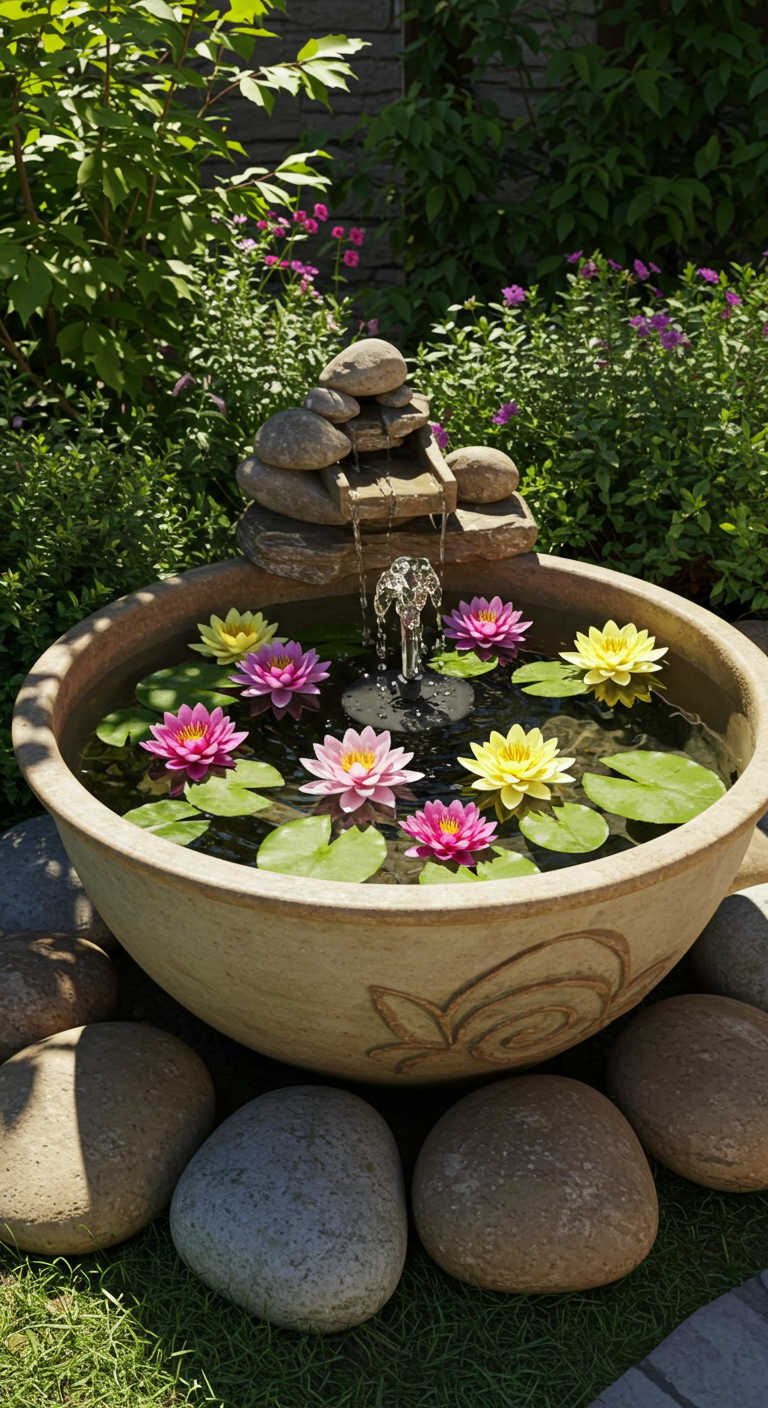
Description
A mini water garden adds a soothing element to your space with the gentle sound of water and the beauty of aquatic plants. These gardens are perfect for patios, balconies, or any spot where you can safely display a water container.
How to Do It
Select a shallow, waterproof container like a ceramic bowl or a repurposed basin. Add water and place aquatic plants like water lettuce, duckweed, or miniature lotuses. Include small floating features like pebbles, driftwood, or even a solar-powered fountain for movement. Keep the water clean by changing it regularly or adding a small filtration system.
Visual Cue
Imagine a decorative ceramic bowl filled with floating water lilies, surrounded by smooth stones, and placed in a sunny corner. The gentle ripples from a fountain enhance the garden’s tranquil atmosphere.
#6 Herb Gardens
Description
Herb gardens are both beautiful and functional, offering fresh, aromatic additions to your meals. These mini gardens can thrive on a windowsill, balcony, or kitchen counter, making them perfect for small spaces.
How to Do It
Use small pots, mason jars, or hanging planters to grow culinary herbs like basil, thyme, parsley, or mint. Ensure the containers have drainage and place them in a sunny spot. For added convenience, label each pot with the herb’s name using chalkboard tags or decorative labels.
Visual Cue
Picture a row of small terracotta pots on a windowsill, each brimming with vibrant green herbs. The subtle fragrance and ease of access make this setup both practical and delightful.
#7 Mini Succulent Gardens
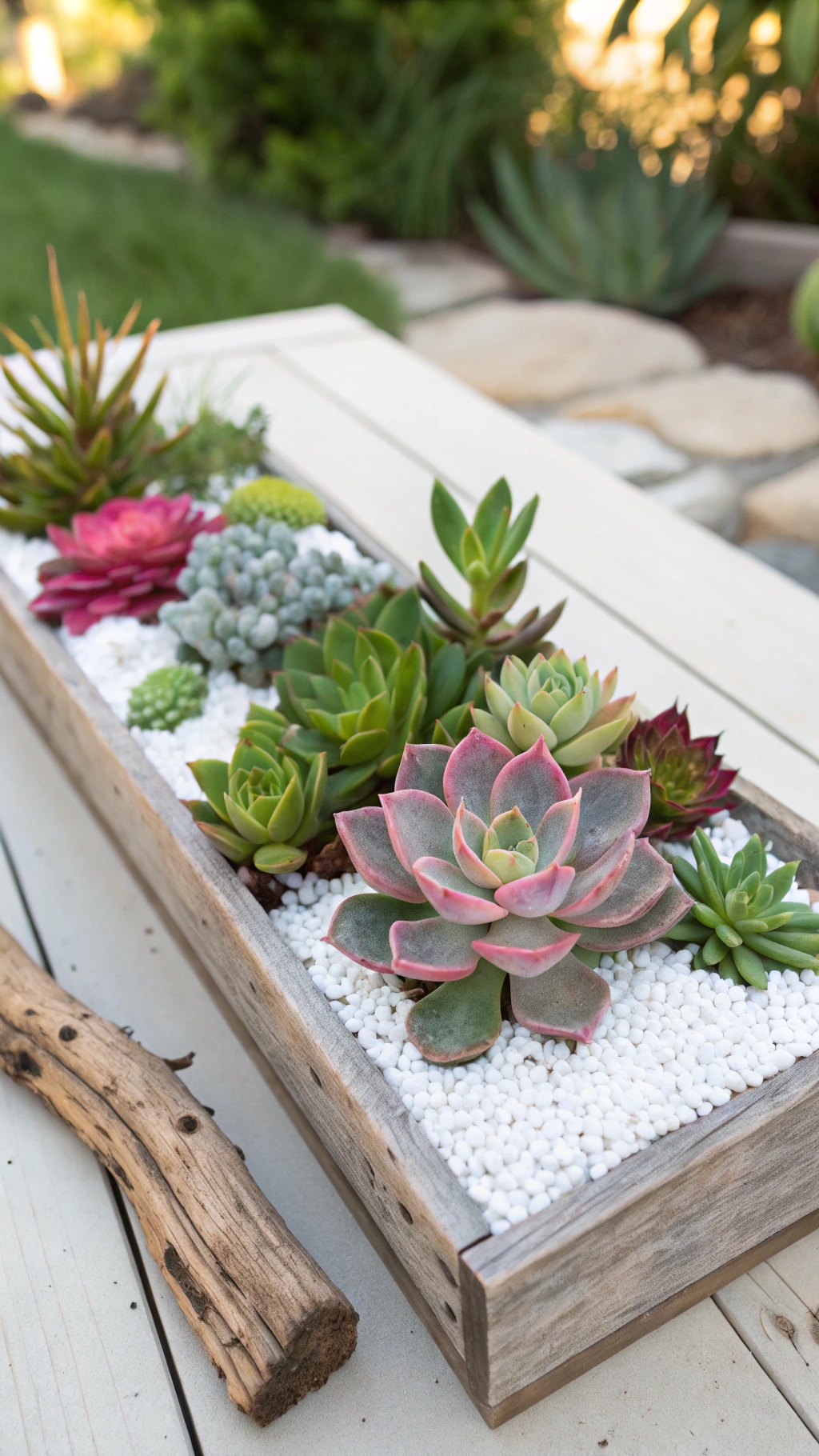
Description
Succulent gardens are popular for their low-maintenance needs and striking appearance. With their unique shapes, textures, and colors, succulents can create eye-catching displays in compact areas.
How to Do It
Choose a shallow container or a terrarium-style glass bowl. Arrange succulents like echeveria, jade plants, or string of pearls in a well-draining soil mix. Add a top layer of decorative pebbles or sand for a polished look. Place the arrangement in a sunny spot and water sparingly, as succulents store moisture in their leaves.
Visual Cue
Imagine a shallow wooden box filled with colorful succulents, their fleshy leaves creating a mosaic of green, pink, and silver hues. Accents like white gravel and driftwood complete the minimalist yet striking display.
#8 Mini Gardens: Balcony Garden
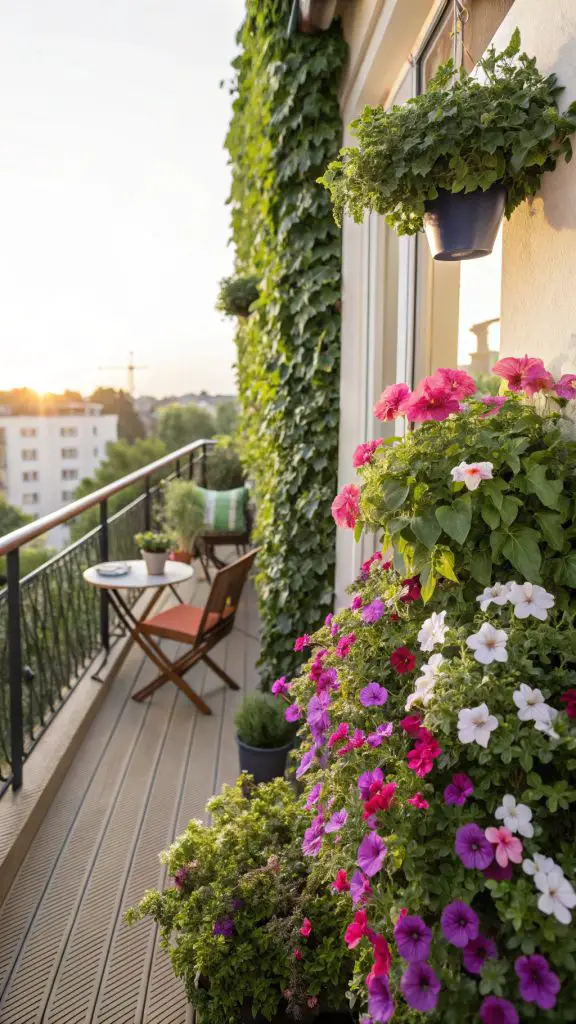
Description
Balconies offer a versatile space for mini gardens, blending vertical and horizontal layouts to maximize greenery. Whether large or small, a balcony can be transformed into a vibrant garden with thoughtful planning and creative use of space.
How to Do It
Use railing planters for flowers or herbs, and add tiered plant stands to create layers of greenery. Incorporate vertical gardening with trellises, wall pockets, or hanging planters. Place larger pots with small trees or shrubs in corners to anchor the design. Ensure the plants chosen match the sunlight and wind exposure of your balcony.
Visual Cue
Picture a cozy balcony with railing planters overflowing with petunias and a vertical trellis covered in lush ivy. A small bistro set surrounded by greenery completes the relaxing atmosphere.
#9 Tabletop Gardens
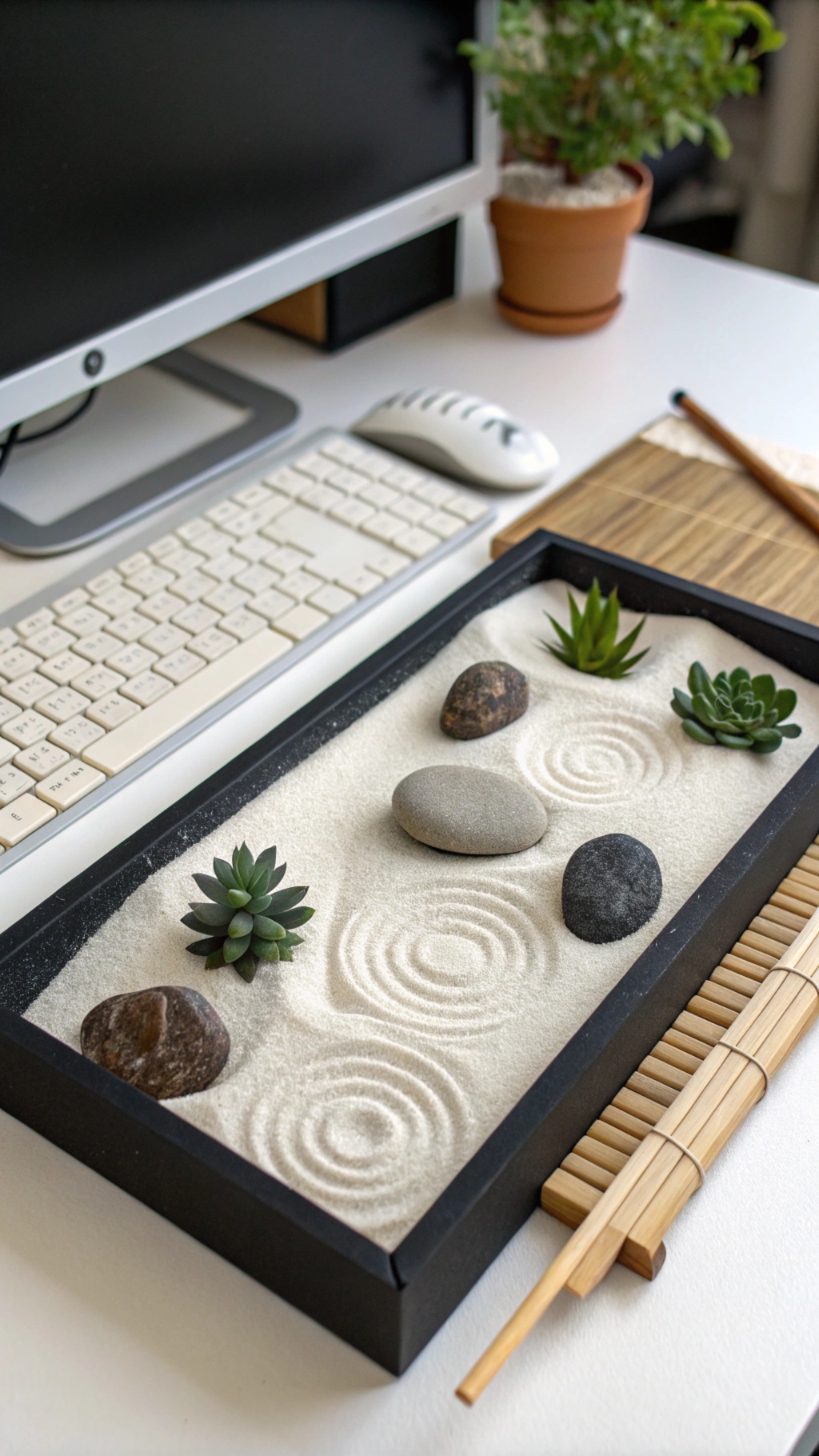
Description
Tabletop gardens are compact and decorative, perfect for desks, coffee tables, or dining areas. These small-scale gardens can serve as charming centerpieces or add a touch of green to workspaces.
How to Do It
Select a shallow tray, bowl, or planter box as your base. Arrange small plants like succulents, moss, or miniature ferns. Add decorative elements like polished stones, driftwood, or tiny figurines for personality. Place the garden in a spot with indirect sunlight and mist it occasionally to keep plants hydrated.
Visual Cue
Imagine a sleek glass bowl filled with moss, tiny ferns, and a miniature stone path, sitting elegantly in the center of a coffee table. This compact garden draws attention while requiring minimal upkeep.
#10 Mini Gardens: Hanging Gardens
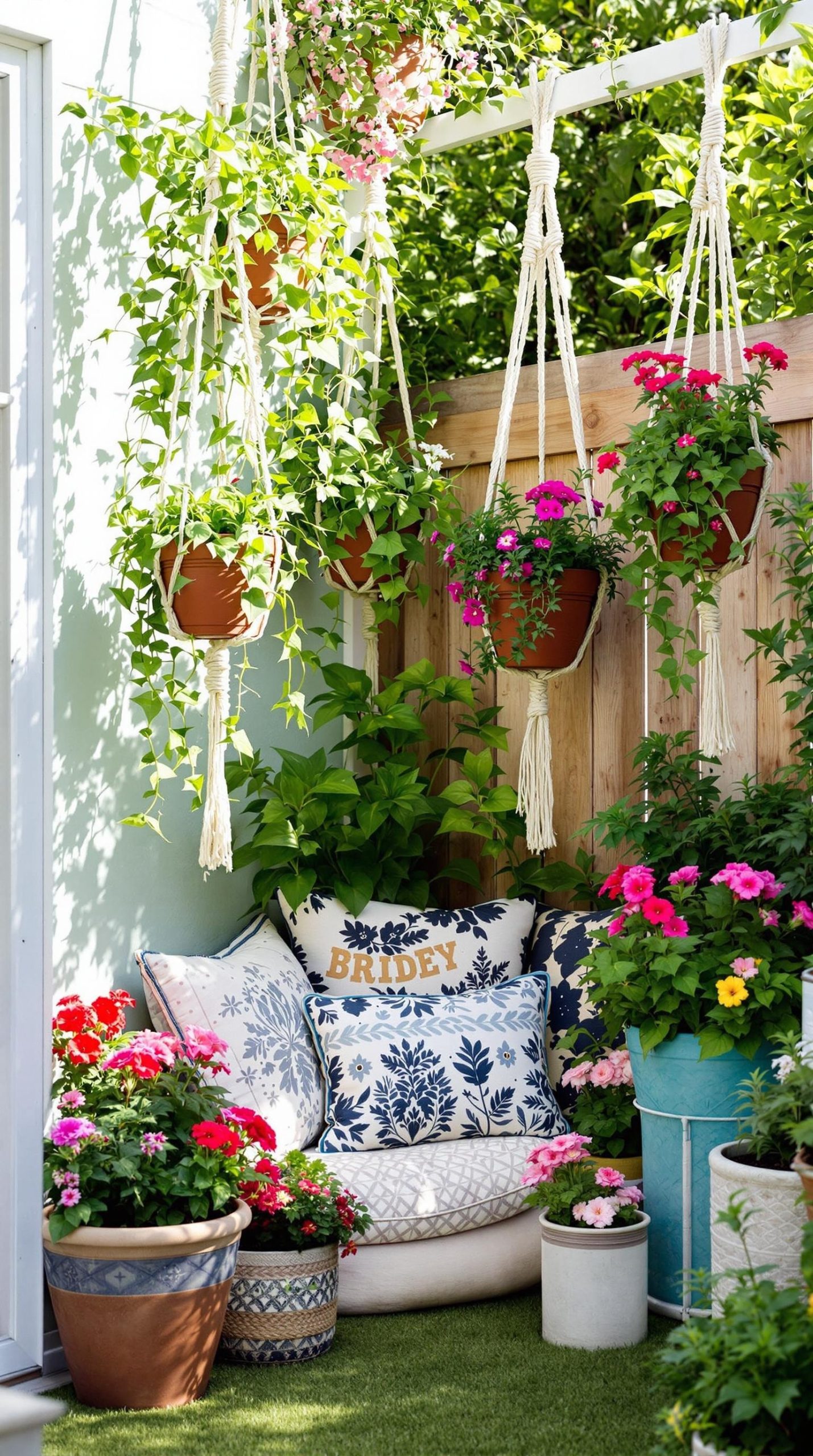
Description
Hanging gardens are a space-saving way to bring greenery into your home. By suspending plants in macramé hangers or wall-mounted planters, you free up floor and shelf space while adding a dynamic, layered look to your decor.
How to Do It
Choose lightweight planters and sturdy hooks for hanging. Use macramé or rope hangers to hold small pots with trailing plants like pothos, string of hearts, or spider plants. For wall-mounted setups, attach pockets or modular planters to a well-lit wall. Water carefully to avoid overwatering or dripping.
Visual Cue
Picture a sunny corner adorned with macramé hangers holding cascading pothos and blooming petunias. Below, a mix of standing planters and floor cushions creates a lush yet organized space.
Tips for Maintaining Your Mini Garden
Watering
Watering is key to keeping your mini garden thriving, but small spaces require careful management to avoid overwatering. Use containers with proper drainage and water only when the soil feels dry. For plants like succulents, watering once every two weeks is often enough. To make watering easier, consider using a spray bottle for delicate plants or self-watering pots for consistent moisture.
Lighting
Proper lighting is essential, especially for indoor mini gardens. Position sun-loving plants like herbs or succulents near windows that receive ample sunlight. For low-light spaces, choose shade-tolerant plants like ferns or invest in grow lights to mimic natural sunlight. Rotate your plants occasionally to ensure even growth and prevent them from leaning toward light sources.
Pruning and Care
Pruning keeps plants healthy and prevents them from outgrowing their containers. Trim dead leaves, overgrown stems, and spent flowers regularly. For miniature rock or water gardens, remove debris like fallen leaves to maintain cleanliness. Use a soft brush to clean dust from succulents or delicate foliage.
Pest Control
Pests can invade even small gardens. To manage them naturally, use neem oil sprays or create a homemade solution with water and dish soap. Check plants regularly for signs of pests, such as yellowing leaves or visible insects. Isolate affected plants immediately to prevent infestations from spreading.
Seasonal Adjustments
Mini gardens require seasonal care to adapt to changing conditions. In colder months, move delicate plants indoors or use protective covers for outdoor setups. During warmer months, ensure plants have adequate hydration and are shaded if the sunlight becomes too intense.
Personalizing Your Mini Garden
Mini gardens are an opportunity to express your personality and creativity. Add decorative stones, fairy figurines, or tiny garden signs to make your space unique. You can even use painted pots or custom labels to enhance the look. Personal touches make your garden more inviting and enjoyable to maintain.
Mini gardens also have emotional benefits. Tending to plants can reduce stress and bring a sense of accomplishment. Whether it’s a whimsical fairy garden or a serene zen setup, let your mini garden reflect your mood and style.
Final Thoughts
Mini gardens prove that size doesn’t limit impact. From vertical gardens to tabletop displays, these small green spaces bring joy, beauty, and health benefits to any area. By carefully planning, maintaining, and personalizing your garden, you can create a space that enhances your daily life and nurtures your connection to nature.
Start small, experiment with different ideas, and watch your creativity bloom. With these mini garden ideas for small spaces, you’ll transform even the tiniest corner into a thriving, vibrant retreat. Now it’s time to pick up those pots and plants—your mini garden awaits!
